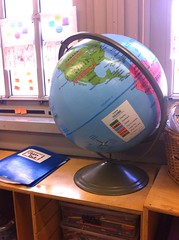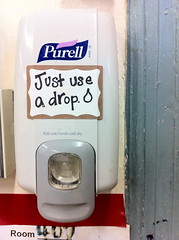Classroom 407 of Neighborhood School, on East Third Street, is decorated with donations: an LCD projector, whiteboard, document camera, globe, games, Seat Sacks – even the Purell hand sanitizer was paid for with outside funds. Now Nancy Shapiro, one of the classroom’s teachers, is hoping to raise money for a soundproofing device that will reduce noise in her room. To do so, she isn’t turning to the Department of Education – she’s relying on DonorsChoose, a Web site that connects donors with teachers who’ve been left strapped by recent budget cuts.
Ms. Shapiro’s classroom holds 28 fourth graders, about forty percent of whom have learning disabilities such as hearing difficulties and attention deficit disorder. Three to four times a day, the class breaks into two smaller groups so that Ms. Shapiro and another teacher, Stephanie Schwartz, can cater to the students’ different needs. The cross-talk between the two groups is so distracting that students have difficulty paying attention or hearing each other, and sometimes end up shouting. The acoustics of the historic building, with its high ceilings, only exacerbates the problem.
“There was one point where we [the teachers] were right in the same part of the story and it was like an echo going back and forth, and the kids were looking from one to the next [teacher] and we couldn’t concentrate,” Ms. Schwartz said.
Whisperwave Baffles, the soundproofing device that Ms. Shapiro is seeking a donation for, doesn’t come cheap: The pieces of curved foam, designed to hang from the ceiling, cost around $260 including installation. Since the online request can take as long as six months to fulfill, Ms. Shapiro and Ms. Schwartz have, as a stopgap, purchased two noise machines on Amazon.com, each spending $55 out of her own pocket.
Teachers in New York City used to have a Teachers Choice fund that allowed them to procure supplies with a fair amount of flexibility. But with that budget shrinking from $260 per teacher to $150 in 2008, then to $110 last year, and now disappearing entirely, more and more school supplies have to come out of the teachers’ pockets, or through P.T.A. fundraising.
“It’s like, how to make an impossible job more impossible?” Ms. Shapiro said. “Take away the supplies.”
Ms. Shapiro and Ms. Schwartz sometimes ask parents to provide pencils, notebooks, glue sticks, paper and binders. But for items that are beyond the means of parents and teachers, DonorChoose proves valuable. Neighborhood School qualifies as a high-poverty school on the site, since over 40 percent of its roughly 350 students are eligible for free or reduced-price lunch.
“Anybody who knows about it tries to use it, because we just don’t have enough,” Ms. Schwartz said.
The soundproofing project is Ms. Shapiro’s 58th request on the website since 2002, when she first started as a teacher in Harlem. Over half of her projects have been funded, allowing her to buy printer ink, file cabinets, books, and even lunch during a field trip to Grand Central Station. Last Thursday, her Time for Kids subscription request was fulfilled, allowing the class to study current events with material suitable for their level of reading.
Amy Masters, another integrated classroom teacher in the Neighborhood School, is also using the site in hopes of funding a digital camera to document classroom activity. And teachers at Children’s Workshop School, another school in the East Village, are attempting to fund seven projects. In total, there are 51 donation requests in the Union Square-Lower East Side area.
“I don’t think that you can manage without it,” Ms. Shapiro said. “If I look around the room, there are just so many things from DonorsChoose – and they really enhance the classroom, which is a place that children are spending eight hours a day, five days a week, awake.”






